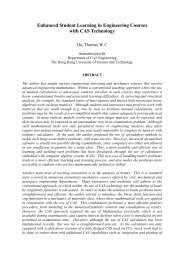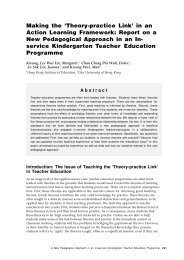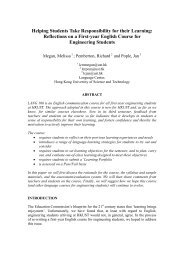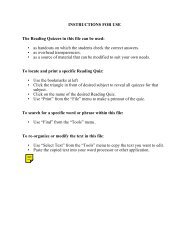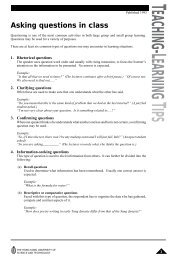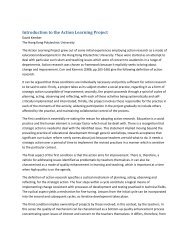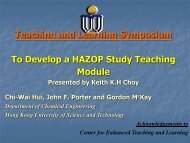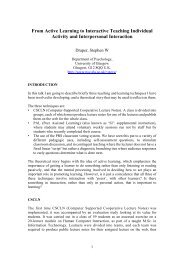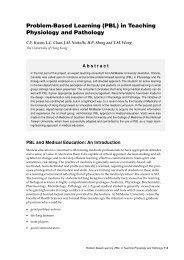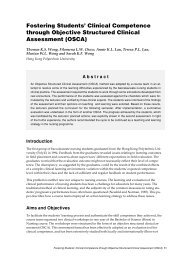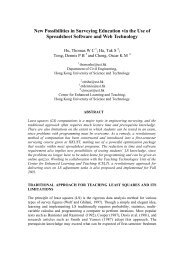Introducing Problem-Based Learning to Teacher Education ...
Introducing Problem-Based Learning to Teacher Education ...
Introducing Problem-Based Learning to Teacher Education ...
Create successful ePaper yourself
Turn your PDF publications into a flip-book with our unique Google optimized e-Paper software.
• The problem is one that students are apt <strong>to</strong> encounter in their future work.<br />
• Subject matter is organised around problems rather than the disciplines.<br />
• Students assume a major responsibility for their own instruction and learning.<br />
• Most learning occurs within the context of small groups rather than lectures.<br />
The PBL introduced in this project was generally a student-centred learning approach in which<br />
team spirit was emphasised. The lecturer acted as a facilita<strong>to</strong>r during the learning process. The<br />
problems were real world issues which enabled students <strong>to</strong> contextualise their understanding<br />
within a simulated policy decision making framework.<br />
Methodology<br />
Subjects<br />
The subjects of this study were students studying the one-year full-time Technical <strong>Teacher</strong>s<br />
Certificate (TTC) Course at the HKIEd. Average class size numbered around 10 students each<br />
year during each of the three cycles in the study. These students were graduates in engineering or<br />
design fields with most at Diploma or Higher Diploma level. Some also had degree<br />
qualifications. They also had industrial experiences before enrolling on the Course.<br />
Methods<br />
PBL was introduced as the teaching and learning approach in the module ‘Current Issues in<br />
Prevocational/Technology <strong>Education</strong>'. This was new <strong>to</strong> most students as it differed considerably<br />
from the traditional lectures and seminar approach they were more accus<strong>to</strong>med <strong>to</strong>. Past<br />
experience in introducing PBL in traditional courses revealed that students always found it<br />
difficult <strong>to</strong> follow at the initial stage (So, & Yu, 1996). It is therefore important <strong>to</strong> provide a<br />
thorough description of the PBL approach and the roles of lecturer and students at the early<br />
stage of the learning process. These include introducing <strong>to</strong> students the concept of PBL, the week<br />
by week processes, the assessment scheme and the possible problems encountered.<br />
There were four components in the overall assessment:<br />
Attendance 10%<br />
Participation<br />
30% (mean of peer, self and lecturer scores)<br />
Five-minute papers 20%<br />
Report<br />
40% (lecturer assessed)<br />
The assessment of participation was based on the student’s contribution <strong>to</strong> class discussions,<br />
demonstration of research efforts, and performance in report presentation. The rationale for such<br />
weightings was <strong>to</strong> enable students <strong>to</strong> have more involvement in both the learning as well as the<br />
assessment of the module.<br />
During the learning process students were required <strong>to</strong> complete a five-minute reflection paper<br />
(Whittle, & Marsh, 1994, p.12) (see Figure I) after each PBL session. The purposes of the fiveminute<br />
reflection papers were <strong>to</strong> stimulate students’ thinking and reflections on their learning<br />
and <strong>to</strong> compare their initial expectations with the outcomes they obtained through research and<br />
group discussions.<br />
<strong>Introducing</strong> <strong>Problem</strong> <strong>Based</strong> <strong>Learning</strong> <strong>to</strong> <strong>Teacher</strong> <strong>Education</strong> Programmes 281



